This is Brazil’s national dish. I’ve been to Brazil twice and have numerous Brazilian friends I count as the funnest and best people around. This recipe comes from my friend, Maria Teresa Eastman, of Campinas. She and her husband have been friends of mine for nearly 30 years now. I ate this at their house for years, but finally imposed on her to teach it to me in my kitchen.
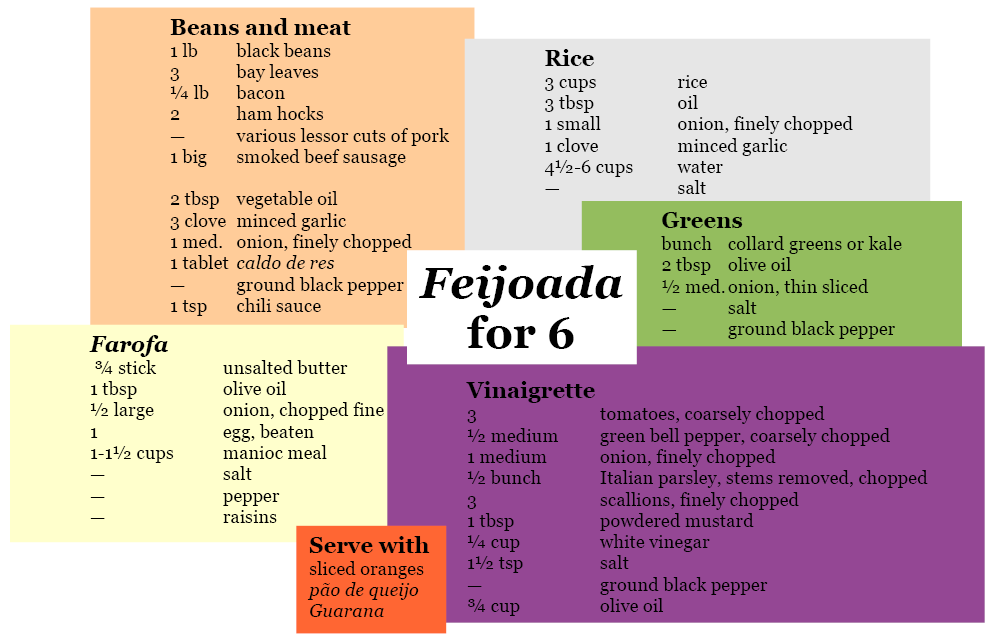
See a shortened version of this recipe. Click on (at the right) and print a refrigerator paste-up to help you with just the ingredients and proportions. See also my ready shopping list.
This recipe is a lot of work the first time you make it. My suggestion is that you perform a mise en place of all the ingredients of all the components. Then apportion off what you need as you cook. If you just make the components in serial, it will take a long time and seem like it takes a long time as you’re performing some tasks over and over again (preparing onions and garlic, for instance) when you could have done them once for all.
History
The way I understand it, when much of Brazil was in slavery, the best parts of slaughtered animals, the pig in particular, went to the owners. Ham hocks, ears, tails, snouts, etc. were left to the lower class who added them to their usual fare of black beans and rice, particularly on Saturday night. The dish that evolved would become common throughout the nation as feijoada and survives even today.
Many rodizio-style barbecues (churrascurias) have salad bars from which you can cobble togther a feijoada, but often parts of the dish are missing or of substandard quality. It’s the ones you make at home on purpose that taste good.
Feijoada consists of 6 separate components or parts and each will be discussed separately here: beans and meat, rice, greens, farofa, a vinaigrette and sliced oranges. Serving on the plate occurs in roughly that order (or so I’ve seen).
Note: The illustrations on this page are of a feijoada for 13 family members one Sunday and therefore not the proportions presented by the recipe (but doubled). The beans and meat were executed in two crock pots for the “2½ hour” cook—while I was at church. However, the crock pot simply will not perform the task in that time, but takes much longer. In the end, doubling this recipe stuffed everyone with enough left over for probably two or three more.
Yield
This amount will easily feed 6 people who want seconds. It scales quite well as illustrated by the pictures here for a 13-person dish. This said, I once multiplied this by 4 for 45-50 people. There were also rolls and pot-luck desserts available. Fully one quarter of the feijoada including rice, meat/beans, vinaigrette, etc. was left over.
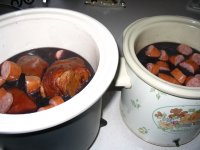
Beans and meat
| 1 lb | black beans (uncooked) | |
| 3 | bay leaves | |
| ¼ lb | bacon | |
| 2 | ham hocks | |
| — | various lessor cuts of pork as desired | |
| 1 big | smoked beef sausage | |
| 2 tbsp | vegetable oil | |
| 3 cloves | minced garlic | |
| 1 medium | onion, finely chopped | |
| 1 tablet | caldo de res | |
| — | ground black pepper | |
| 1 tsp | chili sauce |
1. In a large pot with well-fitting lid, fill to well beyond black beans with water and heat to very hot. Turn off stove and let sit covered for 3 hours. (A pressure cooker will accomplish this in 45 minutes.)
2. When fairly soft or close to it, add in the ham hocks, sausage and bacon. (See illustration.) Cook on medium to medium-low for 2½ more hours.
Note: If you’re using a crock pot (slow cooker) for this step, it will take much longer than 2½ hours; this is all well and good. The important things are a) cook the beans until nice and soft, and b) cook the meat until drop-off-the-bone tender. Last, I tried something I didn’t see my mentor do: I took a few beans in some of the liquid and reduced them to a thickening agent using a hand-held immersion blender. I thought this more pleasant than the thinner, waterier sauce I was getting. While my beans were a little bit al dente, they were fine, but next time, I’m going to be a little more vigilant when using the crock pot. Note that if your slow cooker heats to 400°, you may be able to use that setting to accomplish this in the normal time. My smaller one will not do that.
3. Dissect ham hocks to eliminate bones, fat and skin.
4. Meanwhile, in a smaller pan heated hot, oil bottom and sauté onion until nearly translucent (do not caramelize). Add garlic for a few seconds, then a couple of ladles full of beans and meat from the larger pot. Stir and simmer a couple of minutes, then pour contents of smaller pan back into larger pot. Add more water if too thick.
5. Simmer 10 more minutes covered, stirring occasionally. Then stir in the caldo (boullion cube available in Latin section of grocery store), the pepper and chili sauce.
Simmer a couple of minutes longer, then turn off until ready to eat (other feijoada components prepared). Reheat if necessary.
Rice
| 3 cups | rice (long grain or your choice) | |
| 3 tbsp | oil | |
| 1 small | onion, finely chopped | |
| 1 clove | minced garlic | |
| 4½-6 cups | water | |
| — | salt |
1. Rinse rice or not as desired, but if you rinse, drip thoroughly dry for next step.
2. Cover bottom of large skillet with oil and heat to hot. Sauté the onion, garlic then the rice in the oil, stirring constantly, until much of it is pearly. Add salt.
3. Add boiling hot water in the ratio of 1 cup of rice to 1½-2 cups water. You want to keep the lid on resisting the temptation to remove it for the following step, so learn how much water the rice you choose will absorb and you won’t have to peek.
4. Cover and let simmer on lowest heat for 20 minutes. Check at that time to ensure all the water has been absorbed. Don’t peek under the lid.
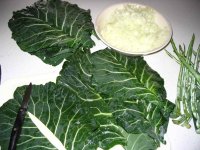
Greens
| bunch | collard greens or kale | |
| 2 tbsp | olive oil | |
| ½ medium | onion, thin sliced | |
| — | salt | |
| — | ground black pepper |
1. Prepare collard greens (or kale) by removing the tough stem parts. Roll together tightly in the manner of a cigar and cut into ½" slices.
2. Heat olive oil in skillet until hot; sauté onion, then greens. Season.
3. Add a little water, then cover and leave 2-3 minutes to soften greens. Place in serving bowl.
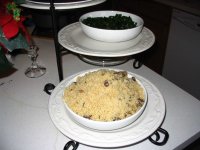
Farofa
| ¾ stick | unsalted butter | |
| 1 tbsp | olive oil | |
| ½ large | onion, chopped fine | |
| 1 | egg, beaten | |
| 1-1½ cups | manioc meal (or Cream of Wheat®) | |
| — | salt | |
| — | pepper | |
| — | raisins |
This is also a separate grain dish in places, see http://en.wikipedia.org/wiki/Farofa. This dish is usually made from toasted manioc root—unavailable where I live. The illustration to the right (and slightly above) is of my farofa with the finished (cooked) greens in the bowl just above it.
1. Melt ¾ of a stick of butter in a sauce pan on medium. Add some olive oil. Sauté onion until translucent.
2. Reduce heat. Stir in beaten egg, then quickly add in the meal and stir vigorously until clumps form. Do not cover pan while cooking.
3. Add salt, pepper and raisins. Place in serving bowl.
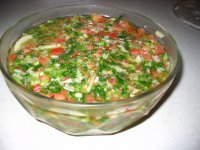
Vinaigrette
| 3 | Roma tomatoes, coarsely chopped | |
| ½ medium | green bell pepper, coarsely chopped | |
| 1 medium | onion, finely chopped | |
| ½ bunch | Italian parsley, stems removed, finely chopped | |
| 3 | scallions, finely chopped | |
| 1 tbsp | powdered mustard | |
| ¼ cup | white vinegar | |
| 1½ tsp | salt | |
| — | ground black pepper | |
| ¾ cup | olive oil |
1. Stir mustard and vinegar together in bowl. Stir in oil, season with salt and pepper.
2. Toss together all vegetable ingredients into vinaigrette.
Note: I once stole a cup or two of this vinaigrette and pureed it to drip, as a garnish, over steak and enchiladas I served the night before. It was delicious and making this vinaigrette ahead of time did not seem to sacrifice its delicious flavors when used the next day. Had I known I was going to do that, however, I might have reserved some especially and substituted a bit of cilantro for the parsley.
Oranges
Slice two or three oranges into ¼" slices and remove the peeling. Arrange on a serving plate.